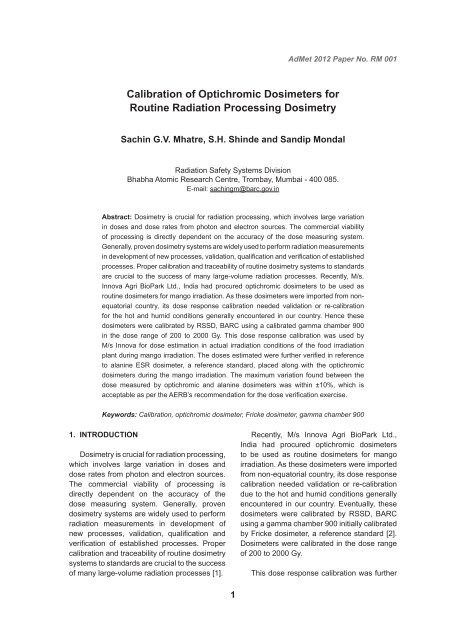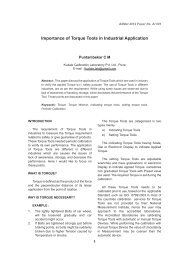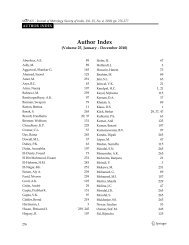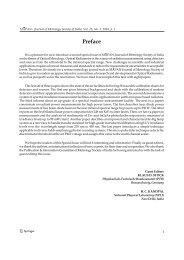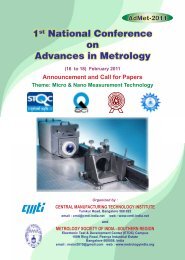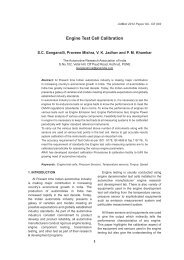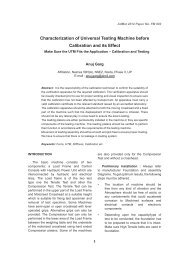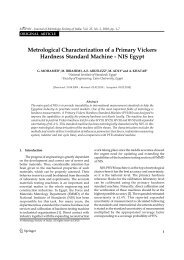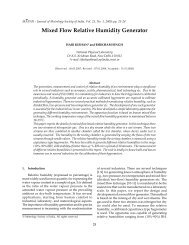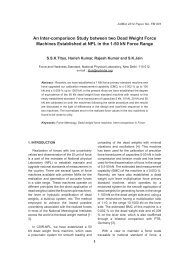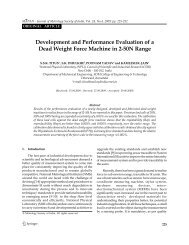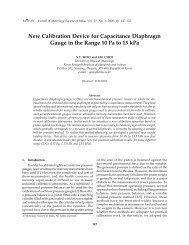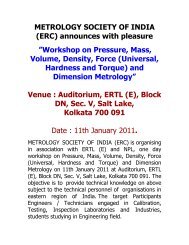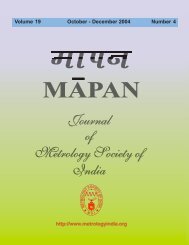Calibration of Optichromic Dosimeters for Routine Radiation ...
Calibration of Optichromic Dosimeters for Routine Radiation ...
Calibration of Optichromic Dosimeters for Routine Radiation ...
You also want an ePaper? Increase the reach of your titles
YUMPU automatically turns print PDFs into web optimized ePapers that Google loves.
AdMet 2012 Paper No. RM 001<br />
<strong>Calibration</strong> <strong>of</strong> <strong>Optichromic</strong> <strong>Dosimeters</strong> <strong>for</strong><br />
<strong>Routine</strong> <strong>Radiation</strong> Processing Dosimetry<br />
Sachin G.V. Mhatre, S.H. Shinde and Sandip Mondal<br />
<strong>Radiation</strong> Safety Systems Division<br />
Bhabha Atomic Research Centre, Trombay, Mumbai - 400 085.<br />
E-mail: sachingm@barc.gov.in<br />
Abstract: Dosimetry is crucial <strong>for</strong> radiation processing, which involves large variation<br />
in doses and dose rates from photon and electron sources. The commercial viability<br />
<strong>of</strong> processing is directly dependent on the accuracy <strong>of</strong> the dose measuring system.<br />
Generally, proven dosimetry systems are widely used to per<strong>for</strong>m radiation measurements<br />
in development <strong>of</strong> new processes, validation, qualifi cation and verifi cation <strong>of</strong> established<br />
processes. Proper calibration and traceability <strong>of</strong> routine dosimetry systems to standards<br />
are crucial to the success <strong>of</strong> many large-volume radiation processes. Recently, M/s.<br />
Innova Agri BioPark Ltd., India had procured optichromic dosimeters to be used as<br />
routine dosimeters <strong>for</strong> mango irradiation. As these dosimeters were imported from nonequatorial<br />
country, its dose response calibration needed validation or re-calibration<br />
<strong>for</strong> the hot and humid conditions generally encountered in our country. Hence these<br />
dosimeters were calibrated by RSSD, BARC using a calibrated gamma chamber 900<br />
in the dose range <strong>of</strong> 200 to 2000 Gy. This dose response calibration was used by<br />
M/s Innova <strong>for</strong> dose estimation in actual irradiation conditions <strong>of</strong> the food irradiation<br />
plant during mango irradiation. The doses estimated were further verifi ed in reference<br />
to alanine ESR dosimeter, a reference standard, placed along with the optichromic<br />
dosimeters during the mango irradiation. The maximum variation found between the<br />
dose measured by optichromic and alanine dosimeters was within ±10%, which is<br />
acceptable as per the AERB’s recommendation <strong>for</strong> the dose verifi cation exercise.<br />
Keywords: <strong>Calibration</strong>, optichromic dosimeter, Fricke dosimeter, gamma chamber 900<br />
1. INTRODUCTION<br />
Dosimetry is crucial <strong>for</strong> radiation processing,<br />
which involves large variation in doses and<br />
dose rates from photon and electron sources.<br />
The commercial viability <strong>of</strong> processing is<br />
directly dependent on the accuracy <strong>of</strong> the<br />
dose measuring system. Generally, proven<br />
dosimetry systems are widely used to per<strong>for</strong>m<br />
radiation measurements in development <strong>of</strong><br />
new processes, validation, qualifi cation and<br />
verifi cation <strong>of</strong> established processes. Proper<br />
calibration and traceability <strong>of</strong> routine dosimetry<br />
systems to standards are crucial to the success<br />
<strong>of</strong> many large-volume radiation processes [1].<br />
Recently, M/s Innova Agri BioPark Ltd.,<br />
India had procured optichromic dosimeters<br />
to be used as routine dosimeters <strong>for</strong> mango<br />
irradiation. As these dosimeters were imported<br />
from non-equatorial country, its dose response<br />
calibration needed validation or re-calibration<br />
due to the hot and humid conditions generally<br />
encountered in our country. Eventually, these<br />
dosimeters were calibrated by RSSD, BARC<br />
using a gamma chamber 900 initially calibrated<br />
by Fricke dosimeter, a reference standard [2].<br />
<strong>Dosimeters</strong> were calibrated in the dose range<br />
<strong>of</strong> 200 to 2000 Gy.<br />
This dose response calibration was further<br />
1
used by M/s. Innova <strong>for</strong> dose estimation<br />
in actual irradiation conditions <strong>of</strong> the plant<br />
during mango irradiation. These doses<br />
were verifi ed in reference to alanine ESR<br />
dosimeter, a reference standard [3], placed<br />
along with the optichromic dosimeters during<br />
the dose verifi cation exercise. The maximum<br />
variation found between the dose measured<br />
by optichromic and alanine dosimeters was<br />
within ±10%, which is acceptable as per the<br />
AERB’s recommendations [4].<br />
2. EXPERIMENTAL<br />
2.1 Materials and methods<br />
All reagents used were <strong>of</strong> analytical<br />
reagent grade and were used without further<br />
purifi cation. Preparation and dose estimations<br />
<strong>of</strong> Fricke dosimeters were carried out as<br />
recommended [2] . Alanine pellets were directly<br />
placed in pre-cleaned polystyrene container<br />
having dimensions 6.5 mm o.d., 32 mm height<br />
and 3 mm wall thickness. For these dosimeters,<br />
dose measurements were made using e-scan<br />
Bruker BioSpin alanine dedicated ESR<br />
spectrometer. Specially designed perspex jig<br />
were used during irradiation <strong>of</strong> optichromic<br />
dosimeters in Gamma Chamber 900 and BI<br />
2000. Absorbance measurements were made<br />
using a calibrated [5] spectrophotometer.<br />
2.2 Irradiation set-up <strong>for</strong> calibration <strong>of</strong><br />
optichromic dosimeters<br />
Gamma Chamber-900 was used <strong>for</strong><br />
dose response calibration <strong>of</strong> the optichromic<br />
dosimeters. Irradiations were done at the<br />
center position <strong>of</strong> the irradiation volume. This<br />
position was calibrated in terms <strong>of</strong> dose-rate<br />
by using Fricke dosimeter [2].<br />
1A<br />
1B<br />
1 Irradiation volume <strong>of</strong> G C-900<br />
2 Build-up 3 Fricke dosimeter<br />
4 <strong>Optichromic</strong> dosimeter 5 Perspex jig<br />
1A Irradiation set-up <strong>for</strong> dose-rate calibration<br />
using Fricke dosimeter<br />
1B Set-up <strong>for</strong> irradiation <strong>of</strong> optichromic<br />
dosimeters at calibrated position<br />
Fig. 1: Irradiation set-up <strong>for</strong> calibration <strong>of</strong><br />
ptichromic dosimeter<br />
2.3 Irradiation set-up <strong>for</strong> dose verification<br />
exercise<br />
During the dose mapping experiment,<br />
single pellet was kept in the buildup and<br />
nine such buildups were placed on each<br />
<strong>of</strong> the three perspex sheets in each <strong>of</strong> the<br />
dosimetry box as shown in Fig. 2. Mangoes<br />
were packed in boxes having dimension 27.5<br />
cm length, 37 cm width and 9 cm height. 20<br />
such boxes in adjacent rows <strong>of</strong> ten each were<br />
packed in the tote box having dimension 150<br />
cm height, 76 cm length and 54 cm width.<br />
Empty spaces around the stack <strong>of</strong> boxes<br />
were fi lled with thermocol sheets. The bulk<br />
density <strong>of</strong> mangoes was found to be about<br />
0.43 g/cc. The total irradiation time was 5 hrs<br />
14 mins and the irradiation temperature was<br />
Specially designed perspex jig as shown<br />
in Fig. 1A was used <strong>for</strong> providing reproducible<br />
irradiation geometry, which was used <strong>for</strong><br />
calibration <strong>of</strong> center position <strong>of</strong> irradiation<br />
volume <strong>of</strong> gamma chamber – 900. During<br />
irradiation each dosimeter was provided with<br />
a suffi cient build-up <strong>for</strong> achieving electronic<br />
equilibrium [6] as shown in Fig. 1B.<br />
Fig. 2 : Dosimetry tote box along with the<br />
perspex sheets and boxes containing<br />
mangoes<br />
2
33 0 C. Each dosimetry box was preceded and<br />
followed by fi ve dummy boxes with the same<br />
product.<br />
3. RESULTS AND DISCUSSIONS<br />
The dose values measured by optichromic<br />
and alanine dosimeters <strong>for</strong> each position in<br />
the dosimetry boxe are tabulated in Table 1.<br />
Atomic Energy Act and Prevention <strong>of</strong> Food<br />
Adulteration Act (PFA) Rules (Ministry <strong>of</strong><br />
Health and Family Welfare) 1994, 1998 and<br />
2001, state that an agreement <strong>of</strong> in the range<br />
<strong>of</strong> ± 10% (1σ) in dose verifi cation exercise<br />
carried out with national standards laboratory<br />
under actual irradiation conditions <strong>of</strong> food<br />
irradiation plant, is acceptable. It is seen from<br />
Table 1 that dose delivered to the mango is<br />
consistent. Also, D min<br />
and D max<br />
values <strong>for</strong> both<br />
the dosimetry systems agree very well.<br />
Table 1: Dose verifi cation exercise between<br />
M/s Innova and RSSD<br />
4. REFERENCES<br />
1. ISO/ASTM Standard 51261, Standard<br />
guide <strong>for</strong> selection and calibration<br />
<strong>of</strong> dosimetry systems <strong>for</strong> radiation<br />
Processing, Annual Book <strong>of</strong> Standards,<br />
American Society <strong>for</strong> Testing <strong>of</strong> Materials,<br />
West Conshohocken, 2002, USA.<br />
2. ASTM Standard E1026, Standard<br />
practice <strong>for</strong> using Fricke referencestandard<br />
dosimetry system, Annual<br />
Book <strong>of</strong> Standards, American<br />
Society <strong>for</strong> Testing <strong>of</strong> Materials, West<br />
Conshohocken, 2003, USA.<br />
3. ISO/ASTM Standard 51607, Standard<br />
practice <strong>for</strong> use <strong>of</strong> the alanine-ESR<br />
dosimetry system, Annual Book <strong>of</strong><br />
Standards, American Society <strong>for</strong> Testing<br />
<strong>of</strong> Materials, West Conshohocken, 2002,<br />
USA.<br />
4. K. H. Chadwick, International doseassurance<br />
in radiation technology,<br />
International Atomic Energy Agency<br />
Bulletin, 1982, 24(3), 21–27.<br />
5. Indian Pharmacopoeia, Ultra violet and<br />
visible spectrophotometry, 1996, India.<br />
6. B. L. Gupta, S. R., Nilekani, and U.<br />
Madhvanath, Dependence <strong>of</strong> dose on<br />
dosimeter thickness under equilibrium<br />
conditions, International Journal <strong>of</strong><br />
Applied <strong>Radiation</strong> and Isotopes, 1978,<br />
29, 700–701.<br />
The Maximum difference observed<br />
between individual Innova and RSSD dose<br />
value was 10%. The Over Dose Ratios <strong>of</strong> 2.46<br />
measured by Innova agree well with the ODR<br />
value 2.79 measured by RSSD.<br />
As overall average dose delivered to the<br />
food product agrees within ±10 % (1σ), the<br />
Gamma Irradiation Facility viz., Innova was<br />
issued license <strong>for</strong> mango irradiation by Atomic<br />
Energy Regulatory Board.<br />
3


